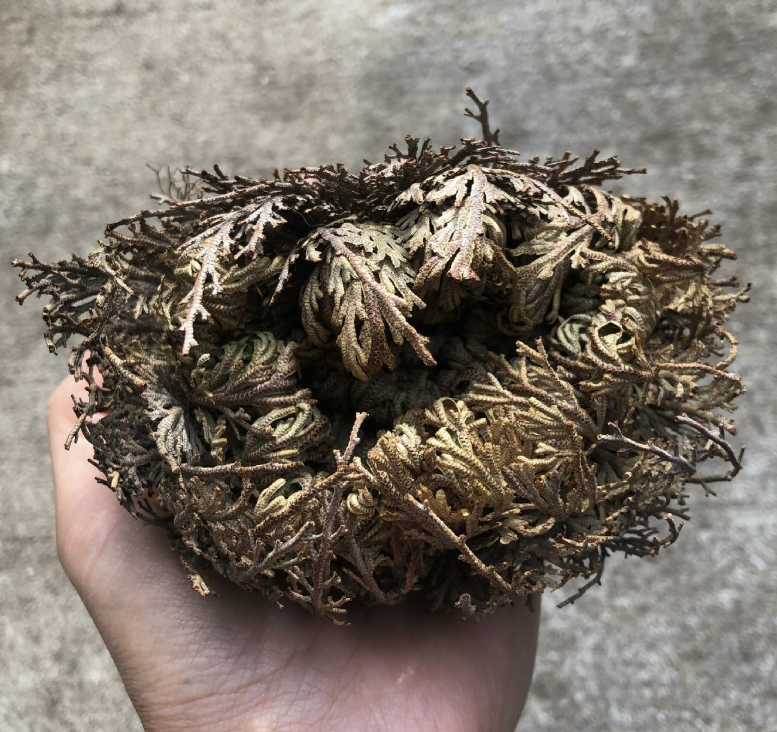The Resurrection Plant, scientifically known as Selaginella lepidophylla, is a truly fascinating plant with an amazing ability to survive extreme conditions.
Also called the Dinosaur Plant, Jericho Rose, or Mary’s Flower, this unique plant can “come back to life” from a dried, dormant state with just a bit of water.
Whether you’re a beginner or a seasoned plant lover, the Resurrection Plant offers a captivating and low-maintenance addition to your indoor collection.
In this guide, we’ll walk you through everything you need to know about Resurrection Plant care, including tips for keeping your plant happy and thriving.
How to Identify
The Selaginella lepidophylla has a distinctive appearance:
- In its dormant state, it resembles a brown ball with tightly curled, dry fronds.
- Once hydrated, the plant unfurls into a fern-like plant with green, feathery leaves.
- Its curling and uncurling make it a popular “living fossil” and symbol of resurrection.
Size
- Typically grows to about 6 inches in diameter when fully hydrated.
- In its curled, dormant state, it’s a compact 2-4 inches across.
Tip: Perfect for small spaces or shallow dishes on shelves or desks!
The Different Types
There are two main plants referred to as Resurrection Plants:
- Selaginella lepidophylla: Found in the Chihuahuan Desert of Mexico and the United States, this is the most popular and recognizable type.
- Anastatica hierochuntica: Also called the True Rose of Jericho, native to the Middle East, it is a different plant with similar behavior.
Light
Resurrection Plants prefer bright indirect light, such as near a south-facing window.
- Avoid direct sunlight, which can scorch the plant.
- In lower light, it may not fully unfurl or grow as vibrantly.
Water
Watering is key to the Resurrection Plant’s care:
- Place it in a bowl of water or shallow dish, submerging only the base of the plant.
- Use distilled water or clean tap water for best results.
- Change the water every 1-2 days to maintain water quality and avoid mold.
- Once fully hydrated (after about 4-8 hours), remove it from the water and place it on a dry surface.
Tip: Don’t leave the plant in water for more than a couple of weeks, as it may start to rot. Allow it to “rest” in a dry place to mimic its natural dormant state.
Temperature
The plant thrives in average room temperatures of 60-85°F (15-29°C).
- Avoid extreme heat or placing it near air conditioners or heating vents.
Humidity
While the Resurrection Plant can tolerate dry conditions, it appreciates higher humidity levels when unfurled.
- Use a humidity tray or mist the air around the plant during dry weather.
Soil
Although the Resurrection Plant can survive without soil, it can also be grown in moist soil if desired.
- Use a mix of peat moss and sand for good drainage.
Tip: Make sure the pot has drainage holes to prevent soggy soil, which can lead to root rot.
Fertilizer
Fertilizer isn’t necessary, but if you choose to grow it in soil, a diluted, water-soluble fertilizer during the growing season (early spring) can promote new growth.
Potting
If potting your Resurrection Plant, select a shallow dish or pot with good drainage.
- Add a layer of stones at the bottom for improved airflow.
Where to Place It in a Home
The Resurrection Plant is perfect for indoor spaces like:
- A south-facing window for good light.
- A shelf or desk as a decorative, low-maintenance centerpiece.
- A bathroom or kitchen, where natural humidity can boost its vibrancy.
Pruning
The plant requires minimal pruning.
- Use clean scissors to trim any dead tips or brownish-green fronds.
Propagation
You can propagate the plant through spores, though it’s rarely necessary. The plant’s ability to enter a dormant state means it often revives itself, eliminating the need for propagation.
Pests
The Resurrection Plant is relatively pest-resistant, but watch for:
- Mold in overly damp conditions.
- Occasional spider mites in dry environments.
Diseases
- Root Rot: Overwatering or poor drainage can cause this. Let the plant dry out completely before rehydrating.
- Mold or Mildew: Avoid leaving stagnant water under the plant for too long.
Is It Toxic?
The Resurrection Plant is non-toxic and safe to have around pets and children.
Common Issues and How to Fix
- Plant Doesn’t Fully Open
- Cause: Not enough water or light.
- Fix: Provide fresh, lukewarm water and move to a brighter location.
- Mold on Plant or Water
- Cause: Stagnant water or poor air circulation.
- Fix: Change the water daily and ensure good airflow.
- Dry Tips Even When Hydrated
- Cause: Low humidity or extreme fluctuations in temperature.
- Fix: Mist the plant or use a humidity tray to maintain consistent moisture.
Difficulty Level
The Resurrection Plant is one of the easiest plants to care for, making it ideal for beginners and plant lovers alike. Its ability to survive extended periods without water and its low maintenance needs make it a perfect conversation piece and a symbol of good fortune.
Final Thoughts
The Resurrection Plant, with its amazing ability to “resurrect” and its unique, fern-like appearance, is more than just a plant—it’s a piece of natural history. Whether you’re displaying it as part of your indoor collection or marveling at its survival skills, this primitive plant offers endless fascination. Follow these tips to keep your springy green little guy happy and thriving for years to come!
FAQ
1. Why is my Resurrection Plant not turning green?
If your Resurrection Plant isn’t turning green after hydration:
- Not enough water: Ensure the base of the plant is submerged in clean water for 4-8 hours.
- Low light: Place the plant in bright indirect light for best results.
- Dormant state: The plant may need more time to transition from its curled, brown ball state to its vibrant green form.
2. Is the Resurrection Plant poisonous to cats?
No, the Resurrection Plant (Selaginella lepidophylla) is non-toxic to cats and other pets, making it a safe addition to homes with furry friends.
3. How does the Resurrection Plant reproduce?
The Resurrection Plant reproduces through spores, a trait it shares with other primitive plants like mosses and ferns. It does not produce seeds or flowers.
4. What is the life span of a Resurrection Plant?
The Resurrection Plant is a living fossil with the ability to survive for decades in its dormant state, provided it is stored in a dry place. When properly cared for, it can “resurrect” repeatedly and live a very long time.
5. Can I grow the Resurrection Plant in soil?
Yes! While it’s often displayed in a dish of water, you can grow it in moist soil. Use a mix of peat moss and coarse sand for optimal soil moisture and drainage.
6. Can the Resurrection Plant survive without water?
Yes, it’s specifically adapted to survive extended periods without water. In its native desert habitat, it enters a dormant state, curling into a ball to conserve moisture.
7. What kind of water should I use for my Resurrection Plant?
Use distilled water or filtered tap water to avoid harmful minerals or chemicals. Always keep the water quality clean by refreshing it every 1-2 days.
8. How often should I water my Resurrection Plant?
Allow your Resurrection Plant to “rest” after it’s been hydrated for 1-2 weeks. Place it in a dry place for another couple of weeks before hydrating it again.
9. Can I keep my Resurrection Plant in direct sunlight?
No, direct sunlight can scorch the plant and cause it to dry out too quickly. Place it in bright indirect light for best results.
10. How can I tell if my Resurrection Plant is dead?
A Resurrection Plant that remains brittle, brownish-green, or shows no signs of unfurling after hydration may be a dead plant. If it doesn’t respond to proper care, it might be time to replace it with a new plant.
11. Does the Resurrection Plant curl up into a ball?
Yes, the Resurrection Plant (Selaginella lepidophylla) curls up into a tight, dry ball when it enters its dormant state. This adaptation helps it conserve moisture in its native desert habitat, such as the Chihuahuan Desert of Mexico. When exposed to water, it “resurrects” by unfurling into a vibrant green, fern-like plant. This process is one of its most fascinating traits, earning it nicknames like the Rose of Jericho and the Dinosaur Plant.

